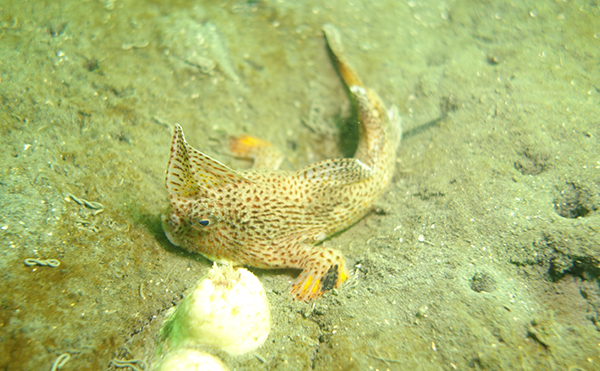Key points
- A runner has snapped a series of photos of a rare and elusive handfish in Tasmania.
- The species is believed to be a critically-endangered spotted handfish.
- It was found in a location where the spotted handfish was thought to be locally-extinct.
Finding a handfish in the wild is like finding a needle in a haystack. But a runner, Kerri Yare, stumbled across this strange and wonderful fish on the shores of Primrose Sands in Tasmania.
Sadly, the animal was no longer alive. But Kerri's sighting – and the photos she captured – are very exciting.
The 8–10 centimetre specimen found is believed to be a spotted handfish (Brachionichthys hirsutus). This is one of seven handfish species endemic to Tasmania and the Bass Strait. In Australia there are 14 species of handfish in total. Scientists onboard our RV Investigator recently found a rare narrowbody handfish Pezichthys compressus).
Our research technician Carlie Devine said the spotted handfish sighting is not just exciting because of what was found - but where.
“Up until last weekend’s find, we thought this spotted handfish population at Primrose Sands was locally extinct, and that it had been since before 2005,” Carlie said.
“We did look a few years ago too, but we didn’t find a single fish. This gives us cause to go looking again.”
A ‘rare and elusive species’
Once plentiful along Tasmania’s east coast, the number of spotted handfish has plummeted over the past three decades. The individuals are solitary and small, making finding them very difficult.

“We may only see one or two fish over a 60 minute dive, and sometimes none. We can estimate there are about 2000 spotted handfish left in the wild,” Carlie said.
In 1996, spotted handfish were recorded as critically endangered on the IUCN red list, becoming the first marine fish to be listed as so.
“They are rare and elusive. Prior to the 1990s, spotted handfish were easily found. However, the population has separated and there are now only nine isolated populations," Carlie said.
“Another two sites, Primrose Sands and Simpsons Point, did have populations but we can no longer find fish in these locations.”
The decline in spotted handfish numbers is believed to have started when they became by-catch from historic near-shore dredge fisheries hunting for scallops. It was exacerbated by coastal infrastructure and the invasive North Pacific seastar, which began to destroy their preferred habitats and spawning substrates.
A critical conservation program
But hope is not lost for the species.
We have been actively working to conserve spotted handfish for more than two decades.
Since the 1996 IUCN listing, we have been collaborating on a research program with the University of Tasmania, Australian and state governments and the Derwent Estuary Program.
Surveys have established that local populations exist at nine small sites in the Derwent Estuary. And, in 2015, an additional local-population was also discovered in the D’entrecasteaux channel.
“We now know that we must monitor these sites every year,” Carlie said.
“We count how many fish we find. And we also provide the fish with artificial spawning habitats (ASH) to lay their eggs on where natural habitats have been decimated.”
Carlie said the introduction of ASH have proven invaluable due to the species’ mysterious breeding habits.
“Part way through the year they aggregate to breed, and this means that they are even harder to find because we don’t know where they go,” she said.
“They do like to use our artificial spawning habitats though, so we can usually find them again.”
A breeding program is also underway.
“We also have what we call an insurance population: fish that we collected from the wild, that live in commercial aquariums,” Carlie said.
“This is so we can keep the species from going extinct. But also to breed the fish, keep the juveniles safe until they are a bit older, and put them back in the river in hopes we can increase numbers in the wild.
“Through this program we've already released a small number of juveniles into the wild and we are excited to see the ongoing impact of our work. We're not done yet.”
